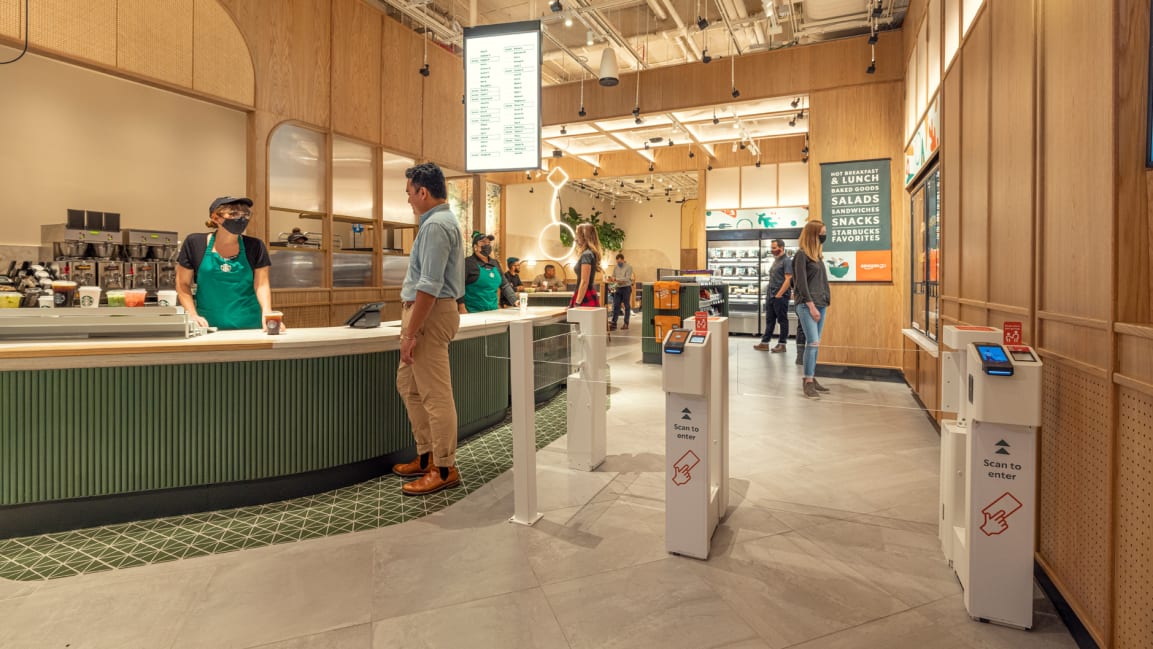For the first time ever, the $133 billion coffee giant Starbucks and the $1.8 trillion dollar retail behemoth Amazon are teaming up on a joint store. It’s one part Starbucks, one part Amazon Go—and opens today in New York City, at 59th Street between Park and Lexington avenues.
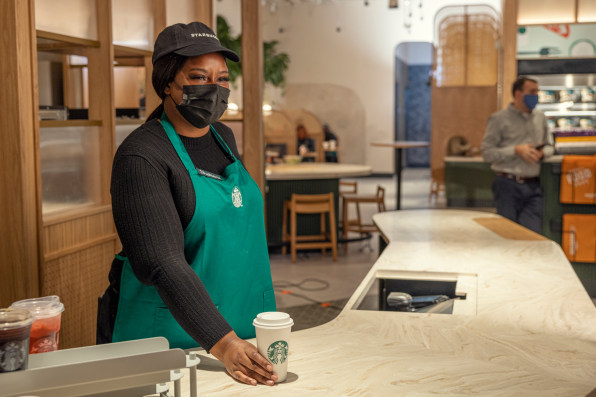
Walk up to the counter like at any other Starbucks, and you’ll see the familiar use of wood finishes and furnishings, natural-stone countertops, and pops of green texture and tile. Starbucks’s own meticulous design team spearheaded the store design, and it shows.“It is meant very much to feel like a Starbucks. It’s a Starbucks store, run by Starbucks baristas,” says Katie Young, SVP of global growth and development at Starbucks. “The intent and reality is to have the fit and finish of a Starbucks.”
Technically, this Starbucks is what the company categorizes as a “pick-up store,” meaning it prioritizes mobile ordering. You can also walk up to the counter, place an order, and pay with cash or credit card.
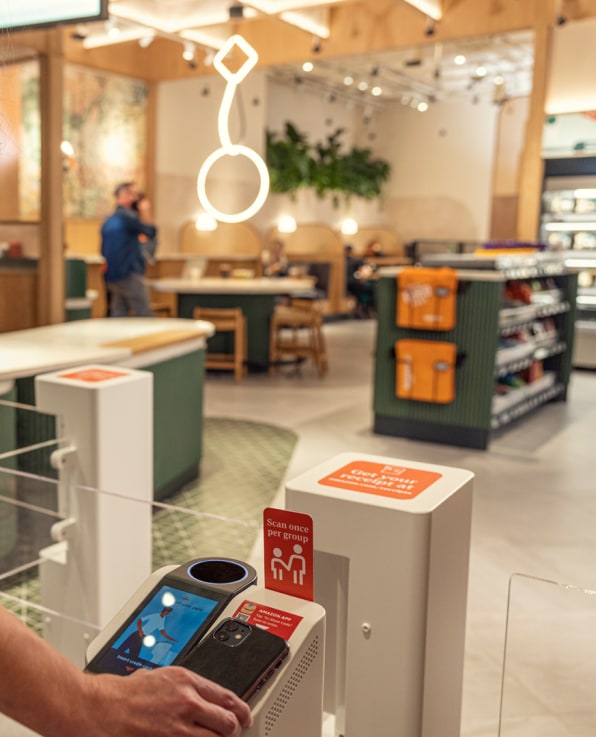
Once you grab your coffee, you can leave . . . or, you bump into a tempered-glass gate that runs all the way up to the counter. This is a classic use of defensive architecture. Like a turnstile on the subway, there’s no sneaking around it unless you jump it. This gate is also a line of demarcation as to where the Amazon Go Store experience begins. You either scan your phone or run a credit card to gain admission to a corner full of sandwiches, drinks, and other snacks. These are stocked by Amazon (though they do include some Starbucks items, like egg bites). Amazon’s AI-driven Go shopping system keeps tabs on you with cameras and other sensors, letting you take anything off the shelf without having to formally check out.
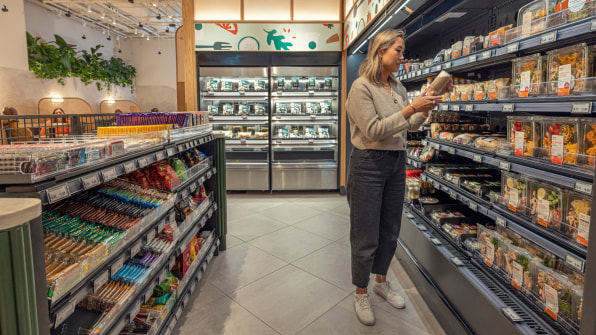
The second part of the store, waiting behind this gate is the Starbucks seating area, where you can either stand at a counter to chug your drink or sit at a booth or table, plug in your laptop, and stay a while. These types of areas have been key to the Starbucks experience for decades; these “third places,” as they’re known, are spaces that aren’t your home or your office, but somewhere else to work, meet people, or just hang out. Technically, you can gain entry to this seating area without scanning your Amazon app, but you need to request access from a barista. I’ve also been assured the Go items can be purchased with cash upon request.
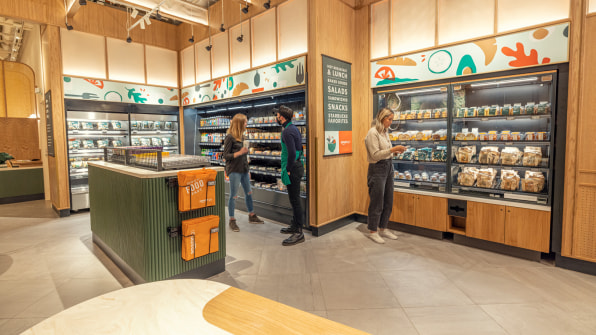
According to Young, this Go store and seating area are “where the Amazon collaboration unlocks a little magic for us.” What is the magic specifically? Young says it’s that if you’re hanging out for a while and suddenly decide you’re hungry, you can just stand up, walk over to the Go store, and grab whatever you’d like, as if it’s your own personal pantry. You don’t need to go back in line at the Starbucks counter, or make some oath with a fellow squatter to watch your laptop.
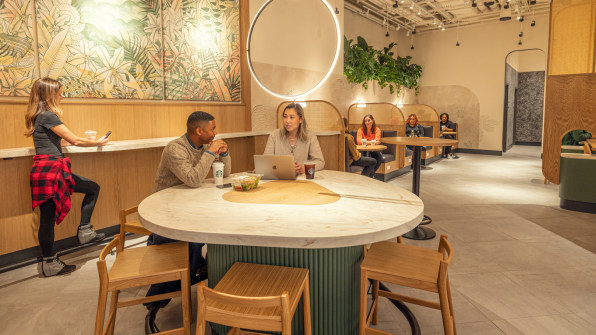
“The reason I’m excited about this is it’s catering to how customers want to go about their day,” says Dilip Kumar, VP of physical retail and technology at Amazon. “Sometimes they’re in a rush, sometimes they have time to spend. This space caters to both kinds of experiences.”Young adds that Starbucks has done a considerable amount of consumer research and that the company is extremely confident in this first store as a result. It plans to open at least two more in the New York City area before the end of 2022.
“The common assumption is the more convenience you focus on, the less connection you have,” says Young. “And we found the opposite is true. The more effortless you make an experience for customers, the more they clear their mind and connect with others.”
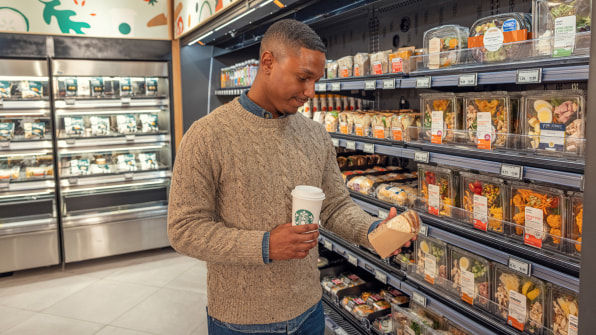
She has a point. No one enjoys standing in a long line, no matter how big someone smiles at the end of it. But I still fail to see what’s in this deal for Starbucks.To contextualize this moment, Starbucks is the gold standard of food and beverage companies, and it solved mobile ordering years ago with a well-designed app and an addictive customer-loyalty program, well before companies like McDonald’s and Taco Bell even launched the option. With just a few taps, Starbucks lets you reorder your go-to drinks for pickup—an experience that’s further incentivized through a steady cadence of alluring special offers in the app. I’d argue that it’s no easier to pick something off the shelf of a Go store, even if there’s no cashier, than to order a Frappuccino from the Starbucks app. And only the Starbucks option allows items to be customized.
What about the promise of eliminating the line? Starbucks has more or less accomplished this in the past. The company offers various levels of table service at their roasteries, allowing you to place an order and have it delivered to you. Which makes me wonder: At this new store, why is a consumer forced to juggle two apps and two companies to order a snack, when the Starbucks app and store experience had already solved this issue?
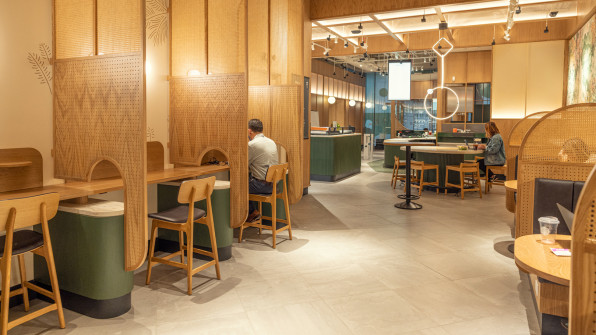
As for Amazon? There’s no question what’s in it for them. The Go store I tried feels like a bodega crossed with a morgue, or perhaps a vending machine extrapolated into concrete. Meanwhile, this Starbucks collaboration will be the most beautiful Go store ever made because it’s been designed by Starbucks’s lauded design team. The lure of Seattle coffee will pull in morning commuters with a predictable rhythm, no doubt feeding sales to the Go store in the process. The high brand affinity for Starbucks will add a halo effect to the Amazon brand. Amazon gets a daily living, breathing focus group of people hanging out in their third places—with people paying for the privilege. And on top of all this, Amazon—the most aggressively monopolistic company in North America—gets a literal front-row seat to study Starbucks’s hyper-efficient food and beverage operations.Neither company will disclose the financial terms of this arrangement, but even if Amazon were paying for the store’s ongoing overhead, it still makes no sense. Starbucks is perfectly capable of balancing its own books with a new coffee shop.
When pressed on what Starbucks is getting out of this partnership, Young insisted the company is excited about the effortlessness Amazon technology will bring to these locations, and about offering customers grab-and-go options sans lines. But bigger picture, I can come up with only two conclusions as to why Starbucks may have taken this deal. Neither is very promising for the company, or for you.
First, Starbucks really is in love with Amazon’s Go technology, and for whatever reasons, has made the error of not developing or acquiring similar technology itself that offers this user experience. Second, the partnership is little more than a defensive play. Perhaps Starbucks imagines a world of physical grocers and other retailers increasingly owned by Amazon, and it would rather keep its enemy close, hoping to carve out corners of Amazon properties for Starbucks stores, or maybe tap into its deep logistical network for distribution or delivery.
But what if, five years from now, Amazon opens its own line of restaurants or coffee shops? Or, what if, whenever you go to sit down in a Starbucks, you hit your knee on an Amazon turnstile? Don’t be too surprised. In terms of design strategy, you’re witnessing what looks to be a rare misstep for Starbucks—and a venti-size score for Amazon.
—
Guest Author: MARK WILSON
This article first appeared in www.marketingprofs.com
Seeking to build and grow your brand using the force of consumer insight, strategic foresight, creative disruption and technology prowess? Talk to us at +971 50 6254340 or engage@groupisd.com or visit www.groupisd.com/story

